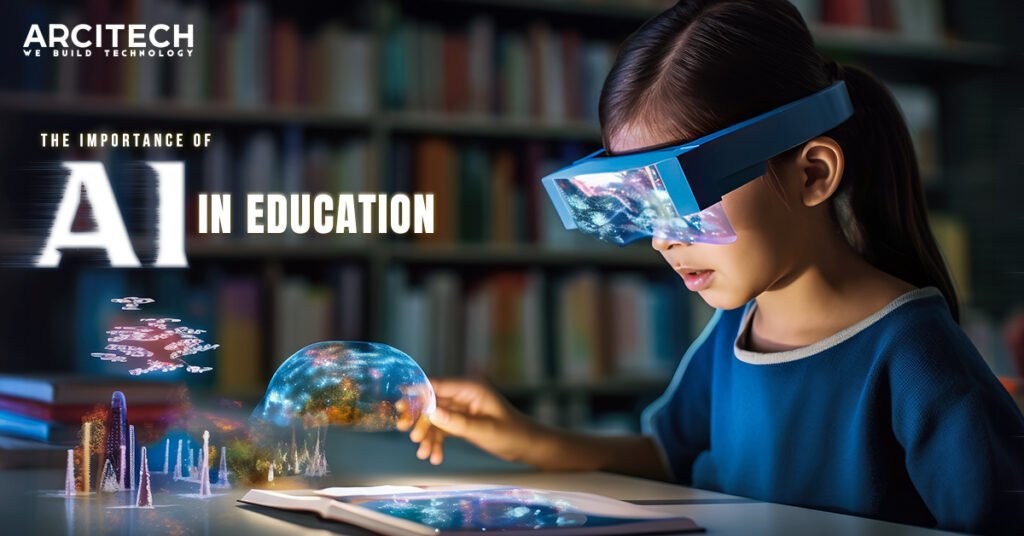How AI Transforms The Learning Experience
The role of artificial intelligence in education (AI) is a field of science focused on creating machines that can imitate human thinking processes. Its primary goal is to make everyday tasks faster and more efficient when set up and maintained correctly. As a result, an increasing number of businesses around the world are starting to use AI.
A report from Research and Markets predicts that the AI market in the U.S. education sector will expand rapidly, with an expected growth rate of 47.77% from 2018 to 2022.
AI systems are generally built on three key principles:
1. Learning: This involves gaining new experiences and forming new ways of behaving.
2. Self-correction: AI continuously improves its algorithms to deliver the most precise outcomes.
3. Reasoning: AI chooses specific algorithms to solve certain problems.
AI comes in various forms, but the most basic ones don’t learn from their experiences.
When it comes to the vast potential of AI, it’s clear that it holds great promise for many sectors, including education. The integration of this technology is seen as one of the most effective ways to transform organizations.
Role of artificial intelligence in education
Artificial intelligence (AI) is changing how we teach and learn worldwide. It’s a powerful tool that helps make learning more tailored to the needs of students, teachers, and tutors.
Here’s how AI can help improve learning:
1. Personalize Education
AI can figure out what a student knows and doesn’t know, creating a custom study plan for each person. It looks at where students might need more help and changes their study material to fit their needs. This makes learning more effective.
To do this, many companies teach their AI systems using something called Knowledge Space Theory. This theory helps the AI understand and fill in the gaps in a student’s knowledge by looking at how different scientific ideas are connected and how one idea can help learn another.
This is what it looks like:

2. Creating Smart Learning Materials:
Digital Lessons AI can create a variety of digital learning tools. These include personalized online platforms, digital books, study guides, and short, focused lessons.
Visualizing Information: AI can present information in new, easy-to-understand ways. This includes using graphics, simulations, and online study spaces.
Updating Learning Content: AI also helps keep lesson material fresh and relevant. It updates content to match the latest information and adjusts it to suit different levels of learning.
3. Helping with Routine Tasks:
Making Admin Work Easier: Teachers spend a lot of time grading, evaluating, and responding to students. AI can help make these tasks quicker and easier.
Think about how Gmail suggests words when you write emails, using your past messages and important business terms. It would be really helpful to have a similar feature in online learning systems or platforms, especially for giving feedback to students.
When AI takes care of these regular tasks, teachers can focus on more important things. This includes grading complex assignments that AI can’t handle, learning new things themselves, and making their lessons better.
4. Providing Personal Tutoring:
- AI can create special study plans that focus on what each student needs to learn. This helps students understand things they find hard during their own study time.
- AI tutors can also help students when they’re not in class. This means students can get help with their work without their parents having to explain tough subjects like algebra.
- AI tutors are a big help for teachers too. They save teachers time because they don’t have to spend extra hours explaining difficult topics.
- Using AI chatbots or virtual assistants, students can ask for more help without feeling shy in front of their classmates.
5. Making Education Easier for Students with Special Needs:
- New AI technologies are creating better ways for students with learning disabilities to learn.
- AI helps make education accessible for everyone, including students who are deaf, have trouble hearing, are visually impaired, or have Autism Spectrum Disorder (ASD).
- AI tools can be specially designed to assist students with various special needs in their learning.
advantage of artificial intelligence for Students
Learning Anytime, Anywhere:
With AI tools available online, students can learn whenever they want. They don’t have to be in a certain place to study. They can learn while traveling, at home, or whenever it suits them best, making a schedule that fits when they feel most ready to learn.
More Interesting Learning:
AI lets students have their own learning plans and special tasks. It uses technology to interact with them and gives personal advice. This makes each student feel important and more interested in their studies, helping them stay engaged and eager to learn.
Reducing Stress for Students
Less Comparing, More Learning: With lessons made just for them, students don’t have to worry about how they are doing compared to others. They can focus on their own learning without feeling pressure.
Easy Help Without Embarrassment: In the past, students had to ask questions in front of everyone in class. Now, they can just type their question into a virtual assistant and get a quick answer, without feeling shy.
Focus on Personal Growth: AI tools let students concentrate on their own progress, not on competition. This means less stress in the classroom and more excitement about learning.
Starting with AI in Learning
Figuring Out What You Need: The first step is to find out what problems you have that AI can help solve. Look for areas that need improvement and see how AI can make them better.
Setting Your AI Goals: Decide if you want to start using AI early or wait and see how it works for others first. Think about what kind of AI fits your needs, the possible downsides, and how to deal with them. Ask yourself what business goals AI should help you achieve. Then, weigh the costs and benefits of using AI.
Bringing Together the Right People and Environment : For AI to work well, you need the right team and a work culture that values data and action. Make sure everyone in your organization is ready to work with AI.
Managing AI Changes Carefully: When you bring AI into your organization, it’s important to be clear about how it will work alongside people. Keep track of important things like how well the AI is doing, any security issues, and the technology you need to support AI. Choose what to measure based on your organization’s unique needs and the type of AI you’re using.
Conclusion
In conclusion, the integration of Artificial Intelligence (AI) into education is not just a futuristic concept, but a present reality with far-reaching implications. By personalizing learning experiences, easing administrative burdens, providing round-the-clock tutoring, and making education accessible to all, AI is reshaping the educational landscape in profound ways.
Implementing AI requires careful planning, clear objectives, and an environment conducive to technological adaptation. By understanding your specific needs, setting strategic goals, and fostering a culture that embraces change, your organization can leverage AI to its full potential. As we navigate this AI-driven educational evolution, it’s vital to maintain a balance between technological advancements and human insight, ensuring that AI acts as a complement rather than a replacement for the human touch in education.
The journey towards AI-enhanced education is an exciting one, filled with opportunities for growth, innovation, and a deeper, more inclusive learning experience for everyone involved. With thoughtful implementation and continuous evaluation, Role of artificial intelligence in education promises to unlock new horizons of learning, making the process more efficient, engaging, and accessible for students across the globe
FAQ
1. What is the primary goal of Artificial Intelligence (AI) in education?
Answer: The primary Role of artificial intelligence in education is to streamline and enhance the learning process by making everyday educational tasks more efficient and effective. This includes personalizing study schedules, improving engagement, and making learning accessible to students with various needs.
2. How does AI personalize education for individual students?
Answer: AI personalizes education by analyzing what each student knows and needs to learn. It creates custom study plans tailored to the individual’s knowledge gaps and learning style. This approach is often based on Knowledge Space Theory, which helps AI understand and fill these gaps by recognizing the connections between different scientific concepts.
3. In what ways does AI reduce stress for students in the learning environment?
Answer: AI reduces stress by providing personalized lessons that eliminate the need for students to compare themselves with others. It also offers easy access to help through virtual assistants, allowing students to ask questions and receive instant explanations without feeling embarrassed in front of their classmates. This focus on personal growth over competition leads to a less stressful and more enjoyable learning experience.
4. What are the key considerations for implementing AI in an educational setting?
Answer: Key considerations for implementing AI in education include identifying the specific needs AI can address, setting strategic goals for AI integration, and creating a supportive environment that values data-driven decision-making. Additionally, it’s important to manage the integration process carefully, keeping track of performance indicators, security concerns, and the necessary technical support to ensure the effective and safe use of AI in educational contexts.
Also Read :-
The Amazing Rise of Claude 2.1: Giving Best AI Potential
Mastering ChatGPT API: Your Guide to AI Integration
The Top 15 AI Tools for Business in 2024 (Both Free and Paid)


